LED Outdoor Sign Lighting: Types, Installation, and Energy Efficiency
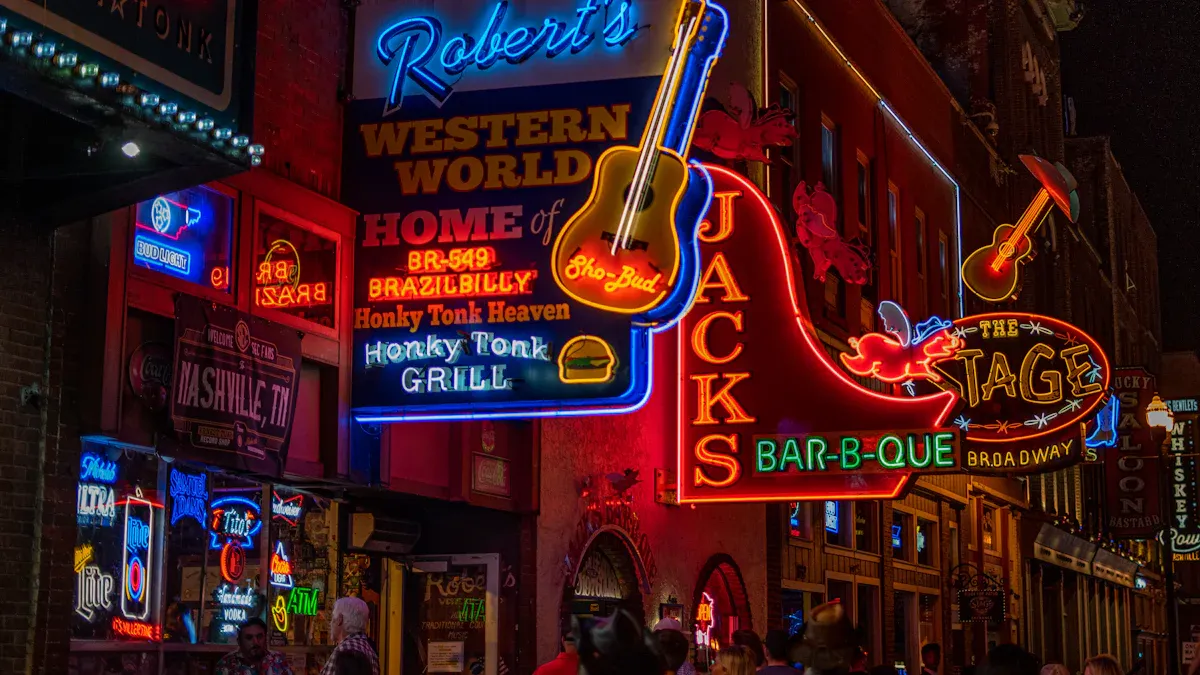
LED outdoor sign lighting makes your signs easy to see all day and night. Many businesses and public places pick LED technology now. This is because it saves energy and lasts longer than other lights. LEDs use only about 20-25% of the energy that incandescent lights use. This means you can save up to 80% on energy.
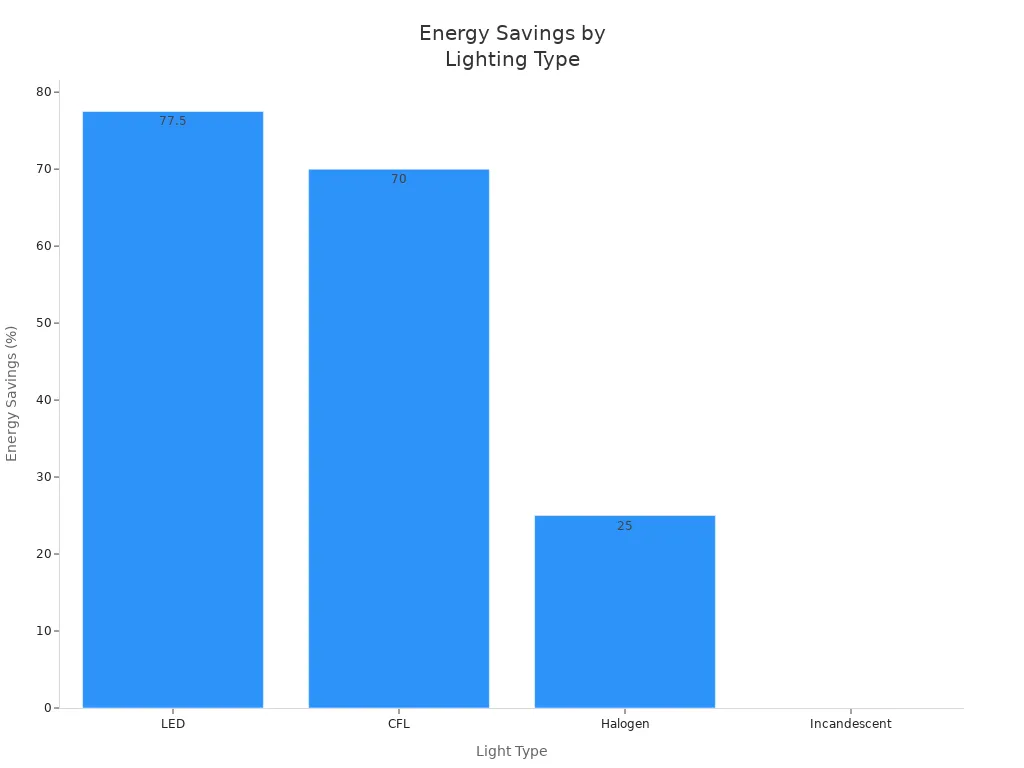
Today, more than half of outdoor sign lighting uses LEDs. You can see how many people use LEDs in the table below:
Metric/Aspect | Statistic/Insight |
|---|---|
LED Penetration in Outdoor Lighting | |
Market Size (2024) | USD 9.57 billion |
Largest Market Share by Application (2023) | Commercial Buildings (45%) |
There are many kinds of LED outdoor sign lighting for different signs. You can use them for stores or billboards. When you choose LED lighting, you save energy and lower your business costs.
Key Takeaways
LED outdoor sign lighting uses 70-80% less energy. It also lasts much longer than old lights. This helps save money and lowers repair needs.
There are many LED types like neon signs, strips, and channel letters. These work for different outdoor signs. They help your business get noticed in any weather.
Good installation uses hardware that does not rust. It also uses waterproof wires. This keeps your LED signs safe and bright for a long time.
LED signs are very bright and clear. You can change their colors and brightness. This makes your message easy to see all day and night.
Picking LED lighting helps the environment. It uses less energy and makes less waste. It also does not use harmful materials.
LED Outdoor Sign Lighting Overview
Benefits of LED Sign Lighting
LED outdoor sign lighting gives your business many good things. These signs are bright and easy to see in any weather. Your sign will show up in rain, snow, or strong sun. The technology uses materials that do not rust or break down fast. This means your sign lasts longer and you do not fix it often.
LED signage is very bright, so people see your sign from far away.
You can make the sign brighter or dimmer for day or night. This helps you not waste energy.
LED lighting signage uses less power than old lights. You save money on your bills.
LED exterior signage can last up to 50,000 hours. You do not need to replace it much.
LED sign lighting is safe for the earth and has no harmful stuff inside.
You can make fun displays with moving lights and color changes. This helps your sign get more attention.
LED signage can use smart tools like sensors and timers. Your lights only turn on when you need them.
Tip: Many businesses say they sell more and people notice them more after using LED signage. You can see these changes if you switch to LED.
Why Choose LED for Outdoor Signs
You want your sign to work well all the time. LED outdoor sign lighting is strong and lasts a long time. LED exterior signage can handle bad weather because it keeps out dust and water. You do not have to change the lights often. LED technology lasts longer than other bulbs.
LED signage helps you follow local rules about how bright your sign can be. You can change the light to stop glare and keep the sky dark at night. LED lighting signage shows bright colors and clear pictures. Your sign will stand out. You also help the earth by using less energy and not using dangerous materials.
LEDs for signage cost less, need less fixing, and are easier to see. LED exterior signage lets you change your sign and keep your message new. Picking LED outdoor sign lighting is a smart choice for your business or group.
Types of LED Outdoor Sign Lighting
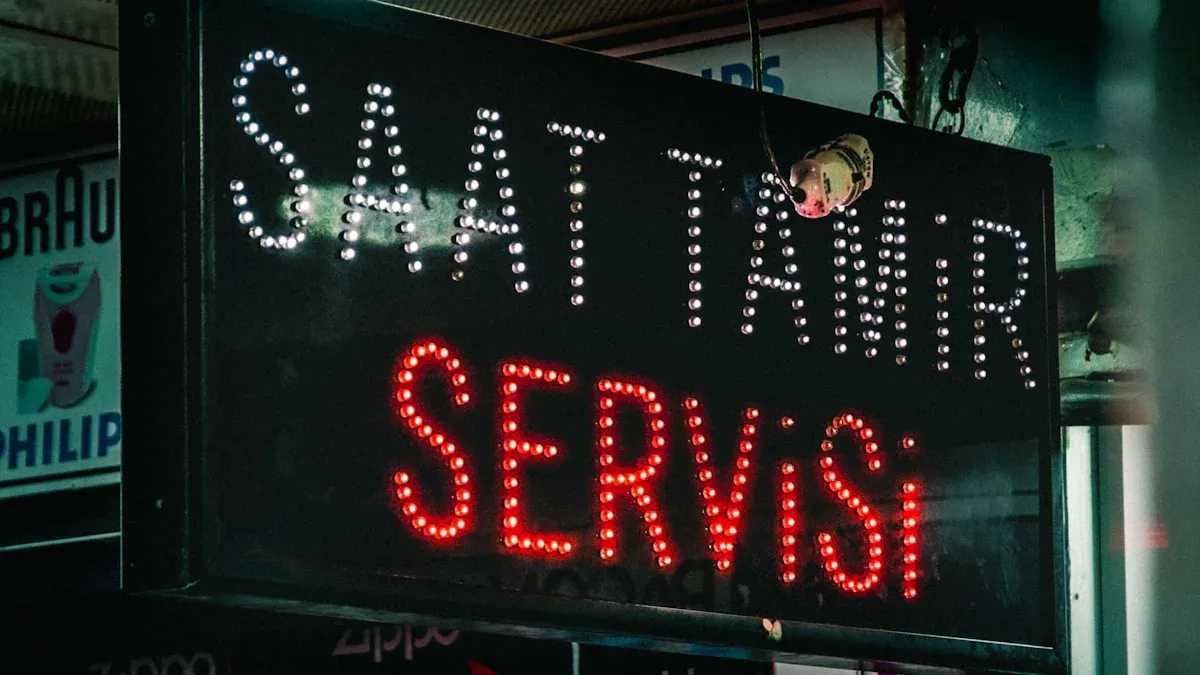
You have lots of choices with LED exterior signage. Each kind works best for certain signs outside. Learning about these types helps you pick what is right for your business.
LED Neon Signs
LED neon signs look like old neon but use new technology. You see them outside stores, in ads, and as decorations. They are made from strong PVC and have a waterproof layer. This helps them last in rain, sun, and wind. You can bend them into letters, logos, or cool shapes. Many businesses use LED neon signs because they are easy to see day and night.
Characteristic | LED Neon Signs for Outdoor Use |
|---|---|
Material | Durable PVC with waterproof coating |
Weather Resistance | Handles moisture, rain, and UV exposure |
Durability | About 10,000 operational hours |
Energy Efficiency | Uses less power than glass neon |
Customization | Many shapes, colors, and designs |
Visibility | Stands out day and night |
Typical Use Cases | Outdoor advertising, branding, decor, directional signage |
You can spot LED neon signs at gyms, restaurants, and stores. For example, gyms use bright neon colors to show their brand and inspire people. These signs help your business get noticed on busy streets.
Note: LED neon signs are safer and use less energy than old neon. You do not have to worry about glass breaking or high voltage.
LED Modules and Strips
LED modules and strips are flexible for many sign projects. You can use LED strips for backlit signs, lightboxes, or edge-lit panels. These strips bend around corners and fit in small spaces. You can cut them to fit your sign.
Feature | LED Strips | LED Modules |
|---|---|---|
Brightness | At least 450 lumens per foot; depends on LED density and efficiency | Varies; often used for channel letters |
Flexibility | Very flexible; fits curves and uneven surfaces | Rigid; best for flat surfaces |
Installation | Easy with adhesive backing; cut to size | Needs mounting; less adaptable |
LED modules are often inside channel letter signs. LED strips work well for backlit cabinet signs and monument signs. Both types last a long time and handle weather, so they are smart for outdoor signs.
Commercial-Grade LED Sign Lights
Commercial-grade LED sign lights are strong and bright for big outdoor signs. You use them for billboards, monument signs, and large store displays. These lights have metal cases, cooling parts, and seals to keep out water. They shine bright even in sunlight and last for years.
Feature | Commercial-Grade LED Sign Lights | Consumer-Grade Options |
|---|---|---|
Durability | Built for 24/7 use, withstands harsh weather | Not for continuous outdoor use |
Brightness | Up to 2,500+ cd/m2, great for outdoor visibility | About 350 cd/m2, best for indoors |
Advanced Features | Remote management, scheduling, network connectivity | Few or no advanced features |
Construction | Metal casing, tempered glass, lockable storage | Plastic casing, less protection |
Warranty & Support | 3-year warranty, strong support | 1-year warranty, limited support |
Longevity | Up to 60,000 hours operation | Shorter lifespan |
You can move the heads of these lights to aim them. Some have sensors that turn on at night or when people walk by. This saves energy and keeps your sign bright only when needed.
Channel Letter LED Lighting
Channel letter LED lighting gives you letters that light up from inside. You see these signs on stores and shopping centers. You can pick front-lit, reverse-lit, or both for your sign.
Channel letters use strong materials like aluminum and acrylic. They stand up to rain, wind, and sun.
LED lighting in channel letters lasts a long time and needs little fixing.
You can pick many colors and brightness to match your brand.
These signs use less power than old lights, so you save money.
Channel letter LED signs are easy to see at night and in bad weather, bringing more customers.
Tip: Getting a pro to install your channel letter sign helps it stay bright and safe for a long time.
Edge-Lit and Direct-View LED
Edge-lit and direct-view LED signs look modern and grab attention. Edge-lit signs have LEDs along the edges to light up the panel. These signs are thin and light, good for menu boards or modern business signs. They use less power because they need fewer LEDs.
Direct-view LED displays put LEDs right behind the sign face. This makes the sign bright and colorful. You see these in digital ads, sports arenas, and big event signs. Direct-view LEDs work well in sunlight and last a long time.
Feature | Edge-Lit LED Technology | Direct-View (Direct-Lit) LED Technology |
|---|---|---|
LED Placement | LEDs on edges, light guided inward | LEDs behind the whole panel |
Design and Thickness | Ultra-slim, lightweight | Thicker, heavier |
Brightness Uniformity | May have uneven brightness on large signs | Uniform brightness, great for large signs |
Contrast and Black Levels | Limited contrast | Deep blacks, high contrast |
Energy Consumption | Lower, fewer LEDs | Higher, more LEDs |
Visual Quality | Good for small/medium signs | Best for large, high visibility outdoor signage |
Suitability for Outdoor | Energy efficient, modern look | Great for sunlight, durable, vivid colors |
Use edge-lit signs for menu boards or wayfinding. Direct-view LED displays are best for digital billboards and signs that need to be seen from far away.
Note: Both edge-lit and direct-view LED signs save energy and last a long time. Pick the one that fits your sign’s size and where you want to put it.
Where to Use Each Type
Here is a quick guide to help you pick the right LED sign for your needs:
Sign Type | Recommended LED Lighting Types | Key Features / Usage Tips |
|---|---|---|
Billboards | LED Slim Flood Lights, LED Bullet Flood Lights | Bright, versatile; uplighting and downlighting |
Monument Signs | LED Slim Flood Lights, LED Bullet Flood Lights | Compact, bright; uplighting and downlighting |
Storefront Signs | Front-lit Channel Letters, LED Neon Effect Lighting, Gooseneck Sign Lights | High visibility, brand impact, decorative appeal |
Each LED sign type works best for different outdoor uses. Picking the right lighting helps your sign stand out and saves energy.
Installation of Signage Lighting LED
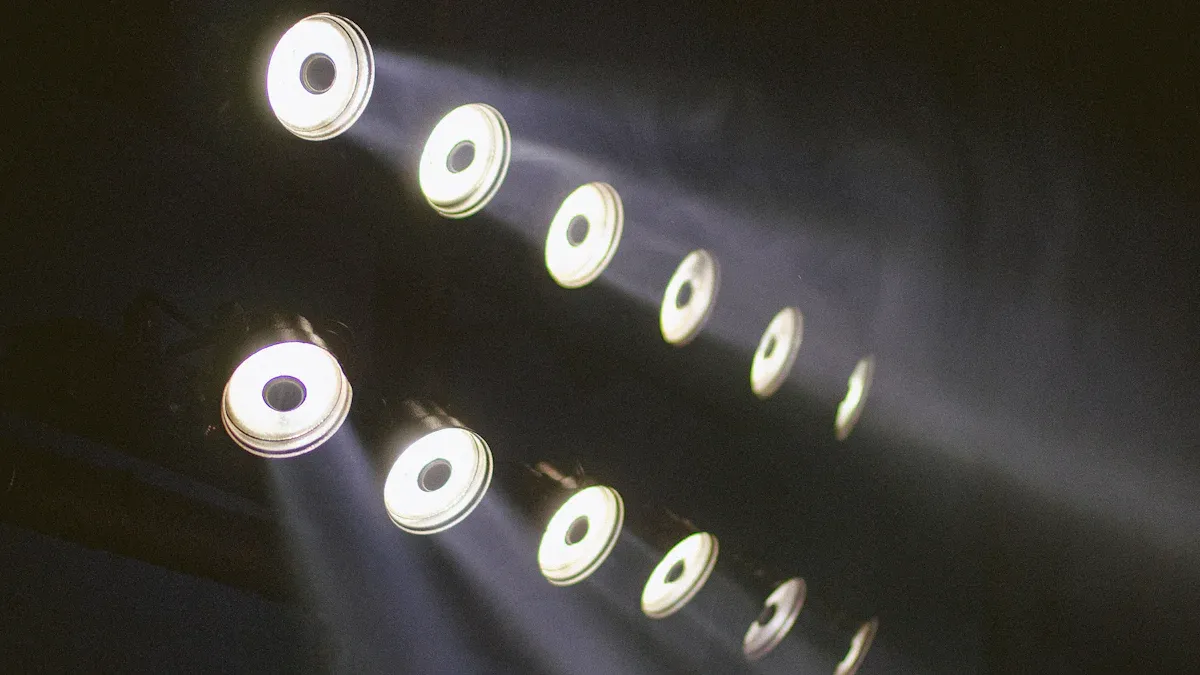
Installing signage lighting led outdoors helps your sign stand out and last longer. You need to follow the right steps to make sure your lighting works well and stays safe in all weather. This section guides you through the main parts of the installation process, from choosing hardware to keeping your system running smoothly.
Hardware and Mounting
You start by picking the right hardware for your signage lighting led. The mounting method depends on where you want to place your sign. You can mount signs above ground, in the ground, or on building parts like overhangs. The surface—concrete, soil, or brick—affects your choice of mounting hardware.
Use corrosion-resistant materials such as aluminum or stainless steel for mounting brackets and arms. These metals do not rust and last longer outdoors.
For straight runs, standard aluminum mounting clips work well. For curved or creative designs, flexible stainless steel strips hold the led neon securely.
Full-length aluminum channels give the most support and help with heat dissipation. These channels also allow you to add waterproof seals for extra protection.
Always use strong anchors, bolts, and brackets to keep your sign stable during storms or high winds.
Add waterproofing materials and drainage features to prevent water from getting inside your sign.
Make sure you leave enough space for maintenance and repairs.
Tip: Always check local rules about sign placement and wind load. This helps your installation meet safety standards and last longer.
You also need the right tools for the job. Bring electric drills, screwdrivers, wrenches, and levels. For large signs, you may need a crane. Do not forget lightning protection and temperature control devices if your area has harsh weather.
Wiring and Electrical Setup
Wiring your signage lighting led correctly keeps your sign bright and safe. Start by planning your layout. Decide where to place the power supply and how to run the wires.
Match the power supply voltage to your led strips or modules. For example, use a 12V driver for 12V strips.
Follow the 30%-80% load rule for power supplies. This means you should use only 30% to 80% of the power supply’s total wattage. This prevents overheating and extends the life of your lighting.
Connect the positive and negative wires from your led strips to the correct terminals on the power supply.
Use waterproof connectors and cables with at least an IP67 rating for outdoor installations.
Cut led strips only at marked points. Use connectors for corners and turns to avoid damaging the strips.
Choose the right voltage for your needs. Use 12V for accent lighting and 24V for larger or brighter signs.
Hardwire your strips for a clean look. Use knockout-version power supplies if you want to control the lights with a wall switch.
Note: Always use power supplies that convert AC to DC and are rated for outdoor use. This keeps your signage lighting led safe during rain or snow.
For commercial signs, follow the National Electrical Code (NEC). Use individual circuits rated at least 20A for most signs. Install disconnect switches within sight of the sign. Ground all metal parts to prevent shocks. Keep all splices in accessible, listed boxes. Mount signs at the right height and distance from vehicles and combustibles.
Safety and Compliance
Safety and compliance matter for every signage lighting led installation. You must follow local sign ordinances and national codes. These rules cover sign size, placement, brightness, and lighting sources.
Check your city’s sign laws before you start. Some places limit how bright your sign can be or where you can put it.
Use lighting fixtures rated for outdoor use. Look for IP ratings and weatherproof seals.
Install emergency lighting that turns on during power loss if your sign is in a critical area.
Keep your lighting glare-free and shadow-free, especially near exits or walkways.
Document all inspections and repairs. This helps you pass OSHA audits and avoid fines.
Hire certified professionals for installation. They know how to install signage lighting leds safely and meet all codes.
Tip: Non-compliance can lead to fines or even force you to turn off your sign. Always follow installation best practices and keep records of your work.
Maintenance Tips
Proper maintenance keeps your signage lighting led bright and working for years. Follow these steps to get the most from your investment:
Clean your led fixtures often with soft, non-abrasive cloths. Dust and dirt can block light and cause overheating.
Make sure your fixtures have good airflow. Avoid placing them in tight spaces where heat can build up.
Use quality led drivers, surge protectors, and voltage regulators. Stable voltage prevents stress and failure.
Choose dimmers that work with your led fixtures. This stops flickering and extends lifespan.
Inspect your lighting regularly. Replace damaged parts right away to keep your sign looking its best.
Use motion sensors or timers to reduce on/off cycles. This saves energy and helps your fixtures last longer.
Pick fixtures with at least an IP65 rating for outdoor use. This protects against dust and water.
Schedule professional inspections to catch problems early.
Upgrade your system as new led technology becomes available. This can improve energy savings and performance.
Note: Smart controls and remote monitoring make it easier to track performance and schedule maintenance. This helps you avoid costly repairs and downtime.
If you follow these steps, you will enjoy the ease of installation, long-lasting performance, and energy savings that come with modern signage lighting led systems.
LED Sign Lighting Energy Efficiency
LED vs. Traditional Lighting
You want your sign to shine bright and save money. LED sign lighting gives you the best energy efficiency compared to older options. Traditional neon tubes use 20 to 40 watts per foot, while fluorescent bulbs can use up to 100 watts. LED neon lights use much less energy for the same brightness. They also create less heat and last longer. You do not have to worry about mercury or other harmful materials with LEDs.
LEDs use semiconductors to turn electricity into light with high efficiency.
Fluorescent lights need more energy and break down faster.
Fluorescent bulbs have mercury, which is bad for the environment.
LEDs can last up to 100,000 hours, while fluorescent bulbs last only 7,000 to 15,000 hours.
LED signs can cut your energy costs by up to 80% compared to fluorescent signs.
LEDs are safe to dispose of and help lower your carbon footprint.
You can see the difference in the table below:
Lighting Type | Power Draw (Watts) | Energy Use (24 hrs, Watts) | Energy Use (1 Year, kWh) | Annual Cost (Colorado, $) | Annual Cost (California, $) | Electricity to Light Efficiency (%) |
|---|---|---|---|---|---|---|
LED Neon Lights | 150 | 1800 | 657 | 80 | 130 | 90 |
Glass Neon Lights | 400 | 4800 | 1752 | 213 | 348 | 20 |
Fluorescent Lights | 610 | 7320 | 2672 | 325 | 531 | 10 |
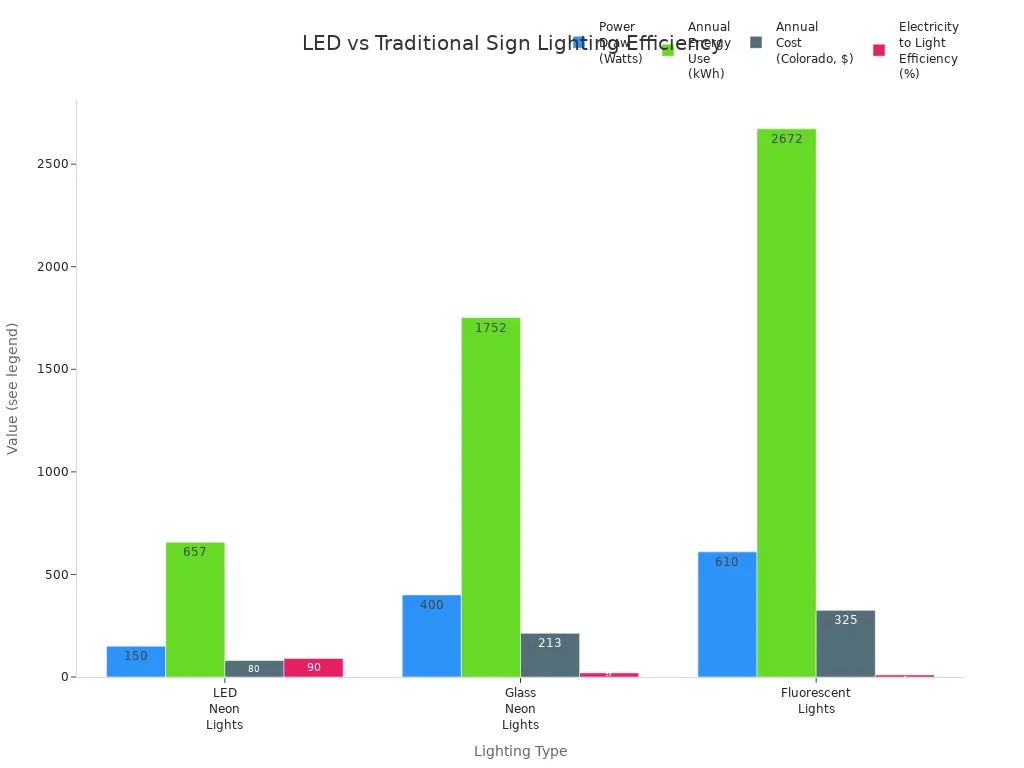
Cost and Energy Savings
Switching to LED sign lighting helps you save money every month. LEDs use up to 80% less power than old incandescent bulbs. For example, a 60-watt incandescent bulb uses 60 watts per hour, but an LED strip uses only about 9 to 12 watts for the same light. This means you pay less for electricity and get more energy-efficient illumination.
LEDs also last much longer. You do not need to replace them as often, which saves you on maintenance costs. You spend less time and money fixing your signs. This makes LEDs a cost-effective option for any business that wants to lower expenses and keep signs bright.
Environmental Impact
LED sign lighting helps protect the planet. LEDs use up to 75% less energy than incandescent bulbs. This cuts down on greenhouse gas emissions. LEDs last up to 50,000 hours, so you throw away fewer bulbs and reduce waste. Unlike fluorescent lights, LEDs do not have mercury or other toxic materials. This makes them safer for you and the environment.
LEDs give off very little heat, which saves energy and keeps your signs safe.
You can use LEDs with solar panels for almost net-zero energy use.
Motion sensors and timers help you use only the energy you need.
LEDs focus light where you want it, which helps reduce light pollution and protects wildlife.
By choosing LEDs, you support energy efficiency and help create a cleaner world.
Outdoor LED Sign Lighting Considerations
Durability and Weather Resistance
If you pick LED signage for outside, you want it to last. It should work in rain, snow, or hot sun. Look for features that help your sign stay safe and bright. Some important things to check are:
High Ingress Protection (IP) rating, like IP65 or higher, keeps out dust and water.
Corrosion-resistant materials such as aluminum or stainless steel with powder coat finishes stop rust.
Sealed electrical parts with gaskets keep moisture from getting inside.
Fixtures rated for low temperatures help your sign work in the cold.
Impact resistance protects your sign from snow, ice, or flying objects.
Strong mounting systems hold your sign up in strong winds or storms.
Surge protectors and backup power keep your sign working if there is a problem.
UV protection coatings help colors stay bright in the sun.
Ventilation or heating elements help your sign in very hot or cold places.
These features help your sign stay safe and bright wherever you put it.
Customization and Flexibility
Modern LED signage lets you make your message special. You can pick from many colors using RGB diodes. This means you can make almost any color you want. You can also change how bright your sign is for day or night. Some systems let you add moving images or animations to get more attention.
You can change the shape, size, or even add your logo to your sign. LED strips come in single color, bicolor, RGB, or special types with control chips. You can pick waterproofing and different strip sizes for your outdoor sign. You can use timers, dimmers, or smart systems to control your sign easily.
Tip: Custom signs help your business stay flexible and keep your message new for every season or event.
Upfront vs. Long-Term Costs
LED signage costs more at first, but you save money later. The table below shows how much you might spend and save:
Cost Category | Typical Cost Range | Notes/Examples |
|---|---|---|
LED Sign Price | $1,000 to $4,000 per square meter | Example: 10 sqm sign ~ $40,000 |
Mounting Hardware | $500 to $5,000 | Depends on mounting type and complexity |
Installation Labor | $1,000 to $10,000 | Varies by location and complexity |
Software Integration | $500 to $5,000 | For content management and control systems |
Annual Maintenance | $1,000 to $5,000 | Includes cleaning, updates, and repairs |
Up to 70% less energy than incandescent signs | Leads to lower electricity bills |
LED signage uses less energy than old lights, so your bills are lower. You also do not have to fix your sign as much because LEDs last longer. Some places give rebates or help with the first cost. Over time, you save money, so LED signage is a smart choice for your business.
LED outdoor sign lighting has lots of good points.
You can save up to 70% on your energy bills. Your sign will last a long time.
Modern LEDs make signs look bright and clear. You can change your message easily.
There are many styles and features to match your brand.
It is easy to take care of your sign. Remote controls let you make changes quickly.
Reality | |
|---|---|
Sign lighting costs too much | LED choices are not expensive and save money later. |
Any light works for signs | Only LEDs give the best brightness and use less energy. |
For the best results, ask a professional or get a free quote from experts like Electro-Matic Visual. Upgrading to LED signs can help your business grow and get noticed.
FAQ
How long do outdoor LED sign lights last?
Most outdoor LED sign lights last between 50,000 and 100,000 hours. You can expect your sign to work for many years with little maintenance. This long life helps you save money and time.
Can you install LED sign lighting by yourself?
You can install small LED signs if you follow instructions and use the right tools. For large or complex signs, you should hire a professional. This keeps your sign safe and up to code.
Are LED sign lights safe in bad weather?
Yes, LED sign lights are safe in rain, snow, and heat. Look for lights with a high IP rating, like IP65 or higher. These lights resist water and dust, so your sign stays bright and safe.
Do LED sign lights save money on energy bills?
LED sign lights use much less power than old lights. You can save up to 70% on your energy bills. This means you spend less money each month and help the environment.
Can you change the color or brightness of LED signs?
Many LED signs let you pick different colors and adjust brightness. You can use remote controls, timers, or smart systems. This helps your sign stand out and match your brand.
See Also
Exploring Various LED Sign Types And Technology Applications
Business Owners’ Guide To LED Sign Boxes: Specs And ROI
Indoor Versus Outdoor Digital LED Signage: A Detailed Comparison
How Rotating LED Signs Enhance Visibility And Return On Investment
Understanding Acrylic LED Light Boxes: Uses And Installation Tips

